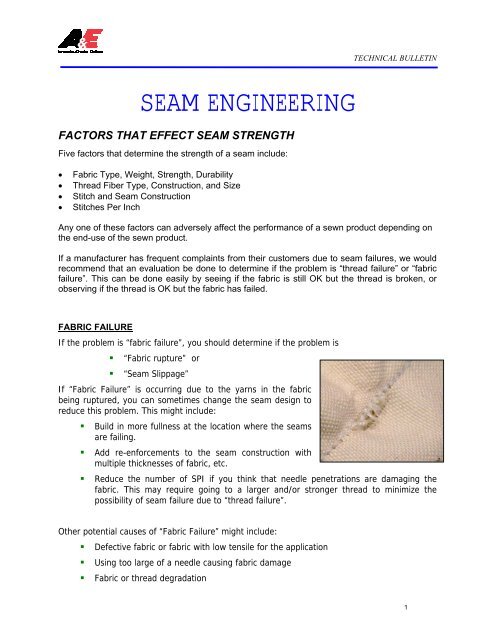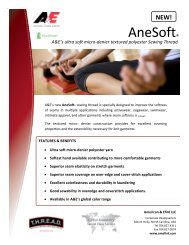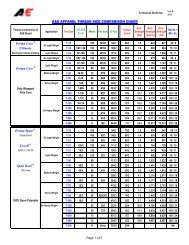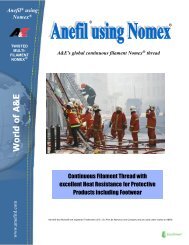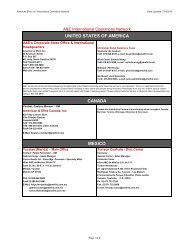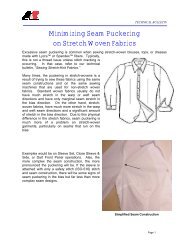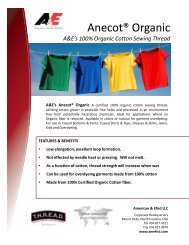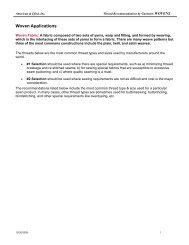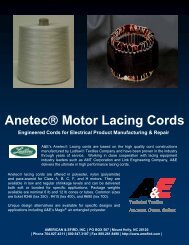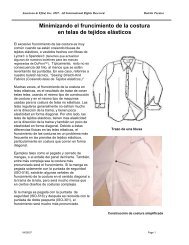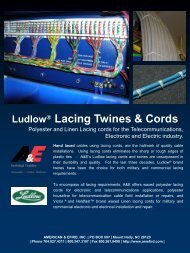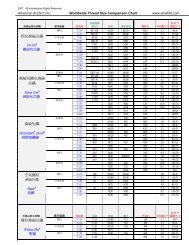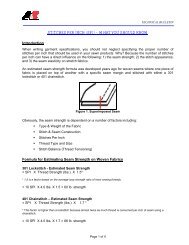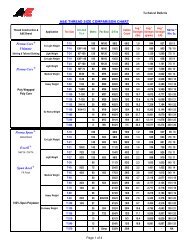Seam Engineering TB
Seam Engineering TB
Seam Engineering TB
Create successful ePaper yourself
Turn your PDF publications into a flip-book with our unique Google optimized e-Paper software.
TECHNICAL BULLETIN“<strong>Seam</strong> Slippage” is when the yarns in the fabric are not rupturing, but sliding out of the seamcausing the seam to open up. If this is the problem, then we recommend the following:• Increase the seam allowance or seam margin.• Re-engineer the seam construction so that all thestress is not trying to separate the warp and fillingyarns in the fabric.• Use a french felled seam construction• Use a fusible tape on the areas where the seams arefailing.• Contact your fabric supplier for assistance.If you are sewing homogeneous type fabrics like leather or vinyl, you will not usually have“seam slippage” but the fabric rupturing under extreme stress.THREAD FAILUREIf the problem you observe is “thread failure”, then you are “under-threaded”. Quality seamengineering relates to many areas of concern including seam strength and seam durability.Obviously the thread plays an important role in all of these areas that are controlled by thefactors shown below.– Thread Fiber Type– Thread Construction– Thread Finish– Thread SizeFor apparel, corespun threads like A&E’s Perma Core ® and D-Core ® are the most durablethread constructions. This is due to their corespun construction where approximately 60% of thethread is a continuous filament bundle of polyester fibers. Core threads are recommended forsewing denim, workwear and uniforms, military garments, etc. that will be exposed todemanding finishing or end-use applications.For most non-apparel sewing applications, a Nylon or Polyester twisted multi-filament thread isrecommended include A&E’s Anefil ® Nylon and Anefil ® Polyester brands. If abrasion resistanceis the primary requirement, we recommend a Nylon thread. If UV and chemical resistance arerequired, we recommend polyester threads. A&E’s SunStop ® polyester thread is similar toAnefil ® Polyester but is made with special UV resistance dyes and finished with a UV inhibiter.THREAD SOLUTIONSThe threads mentioned above are available either bonded or soft. Most manufacturers usebonded threads in the needle positions because they has superior ply security and sewability.2
TECHNICAL BULLETINThey are also available in many tex sizes. Generally, the thicker and heavier the fabric, theheavier the thread Tex Size that will be required.Below are general guidelines for thread sizes being used for non-apparel applications.Automotive Seating T-70, T-90Automotive Restraints T-135, T-150 or T-210Automotive Air Bags T-90, T-135Bulk Bags T-135, T-210, T-270, T-350Filtration T-90, T-135, T-210, T-350, T-400, T-600Furniture T-70Leather GoodsT-45, T-70,Mattresses T-50, T-70Outdoor Products T-70, T-90, T-135, T-210Web Slings & Tie Downs T-135, T-210, T-270, T-350, T-400, T-600For the exact thread size and type you need, please contact your local A&E Sales, GRS orTechnical Solutions representative.Remember: Thread makes up a small percent of the cost of the sewn product, butshares 50% of the responsibility of the seam.SEAM ENGINEERING – THREAD SIZEWe are frequently asked what can be done to overcome seam failure due to “thread failure”besides just using a larger stronger thread. Below are rules for seam engineering that shouldhelp answer this question.301 Lockstitch <strong>Seam</strong>sFor 301 lockstitch seams, we recommend using the sameneedle thread size as the bobbin thread size in the seam.Why? Because “a chain is only as strong as its weakestlink.” If a smaller, weaker thread is used in the bobbin,then the seam will only be as strong as the bobbin thread.Many years ago, with 100% cotton threads, a size smallerbobbin thread could be used and still maintain the sameseam strength. However, with the introduction of polyesterand nylon synthetic fibers that have superior abrasionresistance to cotton, this rule no longer applies.A smaller bobbin thread will allow the sewing operator to wind more thread on the bobbinresulting in fewer bobbin changes and higher productivity. This smaller size thread will alsosave on thread costs. However, the seam strength is now controlled by the size of the bobbin3
TECHNICAL BULLETINAbrasion ResistanceAbrasion resistance has always been an important factor to upholstery, footwear, and carpetmanufacturers. Recently, abrasion resistance has also become important in apparel due to thestringent laundering cycles and pre-wash processes used in garment preparation. Factors thataffect the abrasion resistance of a sewing thread in a seam include:• Fiber Type (nylon, polyester, cotton, etc.).• Fiber size and shape (denier per fil, round, trilobal, etc.).• Thread construction (monocord, corespun, spun, air entangled, etc.).• Thread size.• Stitch and seam construction.Currently, no ASTM, AATCC, or ISO abrasion test exists for evaluating the toughness of sewingthreads. However, A&E conducted comprehensive tests using a modified crockometer toachieve the following results.Thread Type / A&E Brand Tex Size Rating100% Soft Cotton: Anecot T-50 2Glaced Cotton: Anecot Glaced T-60 4Textured Polyester: Wildcat Plus T-35 4Spun Polyester: Perma Spun T-60 5Core (Cotton Wrapped): D-Core T-60 6Core (Polyester Wrapped): Perma Core T-60 7Air Entangled Polyester: Magic T-60 8Soft Poly Multi-filament: Anefil Poly STX T-45 8Bonded Poly Multi-filament: Anefil Poly BT T-45 9Bonded Nylon Multi-filament: Anefil Nylon BT T-45 10(Rated on a scale of 1 to 10 with 10 being the best.)5


